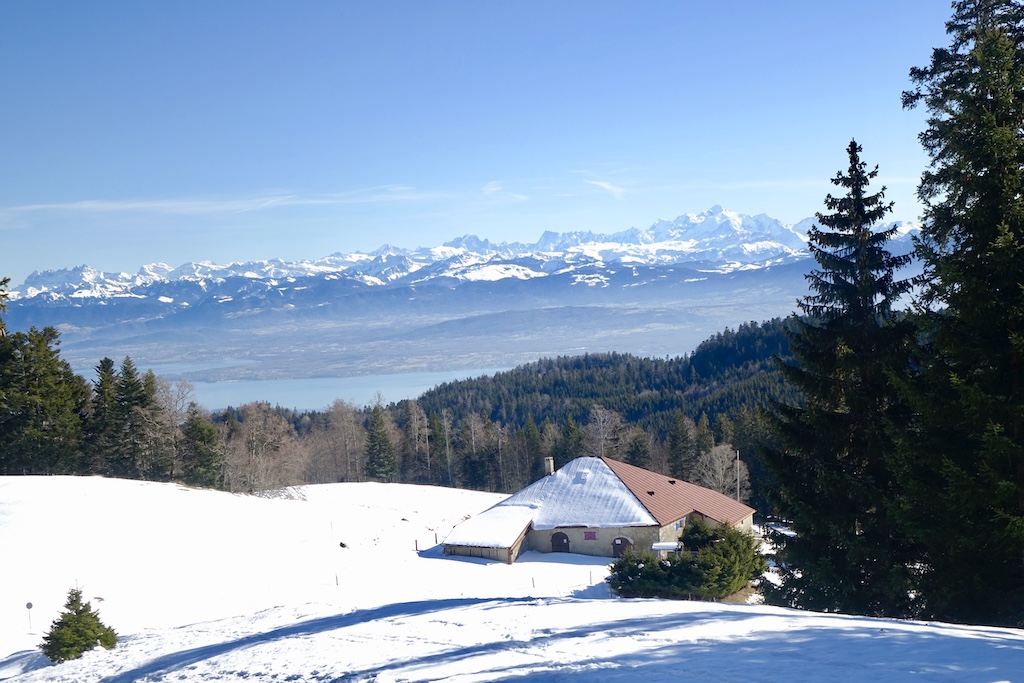 If I have the courage to confess my vulnerability, to share my struggle with a hard to diagnose, difficult to treat, invisible illness ravaging lives, can my words help others in pain?
If I have the courage to confess my vulnerability, to share my struggle with a hard to diagnose, difficult to treat, invisible illness ravaging lives, can my words help others in pain?
Three decades ago, my chiropractor in Switzerland, suspected my back problems were due to more than injuries. He surmised that I had fibromyalgia (FM) a musculoskeletal disorder that causes chronic over-all body pain. He recommended seeing a rheumatologist.
Unfortunately, most people suffering from FM either go undiagnosed for years or are misdiagnosed. On May 12, 1992, Fibromyalgia Awareness Day started to bring attention to this misunderstood disease and commemorate Florence Nightingale, the founder of modern nursing, who also suffered from fibromyalgia.
FM can include fatigue, anxiety, migraines, irritable bowel syndrome, skin sensitivity, stiffness and autonomic 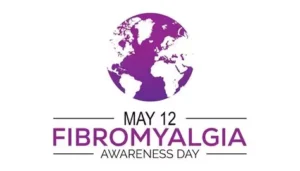 system dysfunction. It impacts the muscles, and can lead to pain numbness, tingling, twitching, restless legs and osteoarthritis. FM also often includes other co-infections and immune system dysfunction, which is why it is paired with CFS.
system dysfunction. It impacts the muscles, and can lead to pain numbness, tingling, twitching, restless legs and osteoarthritis. FM also often includes other co-infections and immune system dysfunction, which is why it is paired with CFS.
With FM, the stress response, an automatic brain reflex, is on autopilot. The brain sends out fight or flight signals with widespread effects. It’s as if one’s body is locked in a state of hyper vigilance, like a smoke alarm going off forever without a fire.
The problem lies with the amplification of pain and sensory processing in the central nervous system. Part of the brain goes haywire in glial cells.
“Most doctors don’t believe FM exists,” my Swiss rheumatologist told me, when he confirmed my FM diagnosis in 1996. “You are lucky that I do. Fortunately, you are protected by your profession. As a physical education teacher, you move all day. Movement is the best treatment for FM.”
At the time of my diagnosis, skepticism reigned within the medical community and general public. I suffered in silence and charged forward, 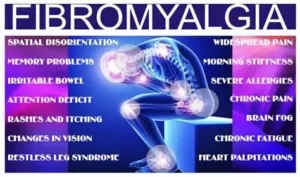 determined to raise a family, teach and coach kids to never give up.
determined to raise a family, teach and coach kids to never give up.
No matter how hard I try to manage pain, FM waxed and waned. Every flare up sent me spiraling in despair.
I remain locked in a state of hyper vigilance and heightened anxiety. FM deregulates sleep causing insomnia. With my body’s inability to enter the deep sleep stage, my muscles and brain never go into a restorative state, which results in muscle tenderness/pain/inflammation.
Specialists know that FM disrupts hormones, burns out adrenal glands, increases chronic pain and affects the sympathetic nervous system, but they still don’t know how to diagnose or treat it.
The clinical signs are nonspecific and overlap with other diseases. Ironically, researchers found eerie similarities between FM and long COVID, which helps legitimize FM. Research on long-haul COVID, which has similar effects, may offer hope.
Experts also know that fibromyalgia tends to run in families. My paternal grandma suffered from it back in the early days when FM was known as rheumatism or fibrocystic. My sister also has fibromyalgia.
Due to a lack of research and the difficulty in identifying causes of the illness, many practitioners still do not believe that the disease exists.
Believe me it’s real. As an iron-willed McKinzie descendant, resiliency is my middle name. As a former pro athlete, who has overcome many debilitating injuries, I am as tough as they come. Yet, the pain of FM can knock me to my knees.
Though the cause is unknown, there is a genetic predisposition. FM often manifests after a car accident, (check) or illness like Lyme disease (check 2) and the physical or emotional trauma after the loss of a loved one, parent or child (check 3).
There is no known cure, but thankfully fibromyalgia is not a death sentence like some forms of cancer and other illnesses.
My health is compromised, but I am still here fighting!
Many treatments fall short. Sleep aids to regulate sleep dysfunction, myofascial massage, exercise, diet, yoga, relaxation and breathing techniques can help.
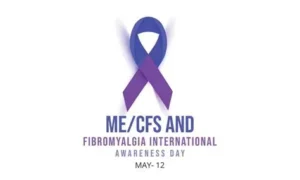 I am not a trained heath practitioner. I cannot offer medical advice, but as a fellow human being,
I am not a trained heath practitioner. I cannot offer medical advice, but as a fellow human being,
I can share insight on how to cope.
I can validate that your pain is real.
I can remind you that you are not alone.
I can you cheer you on from my mountaintop!

 Though fewer people are flying abroad this summer, visitors are welcome everywhere in the UK and Europe. For travelers, who dare to hop the Big Pond, easyJet airlines offer low cost flights to most anywhere from the UK or Switzerland.
Though fewer people are flying abroad this summer, visitors are welcome everywhere in the UK and Europe. For travelers, who dare to hop the Big Pond, easyJet airlines offer low cost flights to most anywhere from the UK or Switzerland. What you economize on your ticket, you pay for in wear and tear on your body. Taller, bigger build bodies beware! Space is limited. Seats do not recline. This no frills airline offers minimal comfort and service in order to maintain bottom line costs.
What you economize on your ticket, you pay for in wear and tear on your body. Taller, bigger build bodies beware! Space is limited. Seats do not recline. This no frills airline offers minimal comfort and service in order to maintain bottom line costs. Boarding from the tarmac, like the old days, can be chaotic.
Boarding from the tarmac, like the old days, can be chaotic.
 In my travels while living abroad for the past 45 years, I’ve perched in fine French cafes, “gemütlich” German bars, and inviting tavernas across Europe, but, England’s oldest pub,
In my travels while living abroad for the past 45 years, I’ve perched in fine French cafes, “gemütlich” German bars, and inviting tavernas across Europe, but, England’s oldest pub, 
 The Porch’s original features, including steep, crooked staircases, open fires, oak beams, and long-forgotten underground passageways, would be worth a detour on any European tour.
The Porch’s original features, including steep, crooked staircases, open fires, oak beams, and long-forgotten underground passageways, would be worth a detour on any European tour. From the moment I ducked through the front door, I was cast under a spell from witches of the past. In the dining room, I studied the witch symbols scratched on the 16th Century fireplace that once warded off evil spirits.
From the moment I ducked through the front door, I was cast under a spell from witches of the past. In the dining room, I studied the witch symbols scratched on the 16th Century fireplace that once warded off evil spirits.

 I climbed into the steel reinforced bunkers overlooking the Normandy landing beaches on Pointe du Hoc eighty years after the Rangers overtook the strategic German lookout 90 feet above the English Channel. I pictured a 19-year-old American boy jumping out of a PT boat into icy waters, with nothing more than a gauze bandage for comfort on a stormy dawn illuminated by gunfire.
I climbed into the steel reinforced bunkers overlooking the Normandy landing beaches on Pointe du Hoc eighty years after the Rangers overtook the strategic German lookout 90 feet above the English Channel. I pictured a 19-year-old American boy jumping out of a PT boat into icy waters, with nothing more than a gauze bandage for comfort on a stormy dawn illuminated by gunfire.



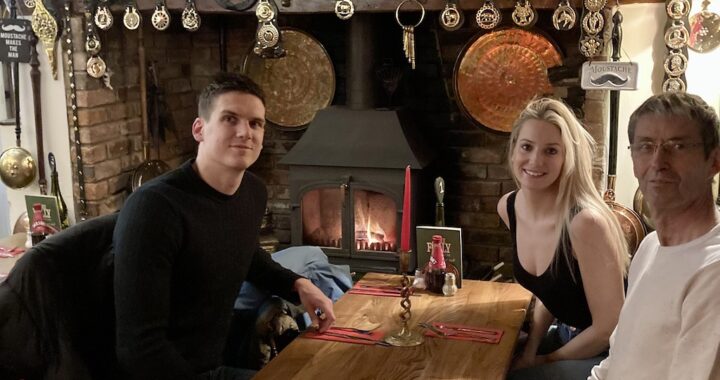
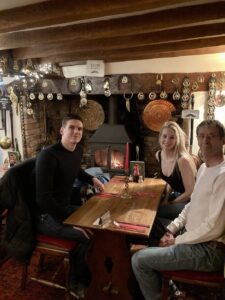 When my son married a beautiful British-Irish-Ukrainian woman, we were given an insiders peek into UK life, which begins and ends at the local pub. Going to the pub for a pint is as much a part of British life as a coca cola and Friday night football is to an American.
When my son married a beautiful British-Irish-Ukrainian woman, we were given an insiders peek into UK life, which begins and ends at the local pub. Going to the pub for a pint is as much a part of British life as a coca cola and Friday night football is to an American.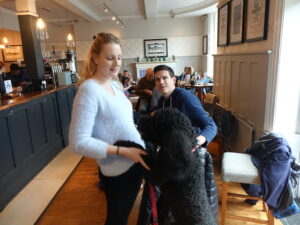
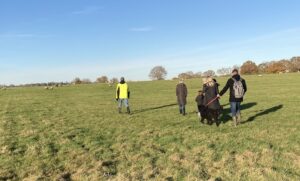 “I don’t see any signs allowing us to hike on their property,” I said.
“I don’t see any signs allowing us to hike on their property,” I said.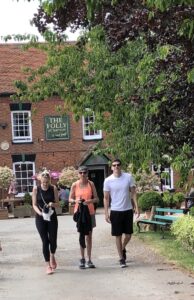 “A phone app indicates where it is okay to go,” said Larissa. “But it’s mostly common sense. You wouldn’t walk through field of donkeys or free range horses. It’s at your own risk if you try to cross a field of buffalo.”
“A phone app indicates where it is okay to go,” said Larissa. “But it’s mostly common sense. You wouldn’t walk through field of donkeys or free range horses. It’s at your own risk if you try to cross a field of buffalo.”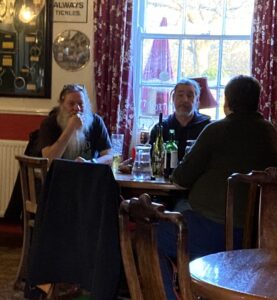 drinks, after our hike, we were so thirsty, we opted for cokes, beer, and the local cider. The little boys sat politely at the table enjoying snacks.
drinks, after our hike, we were so thirsty, we opted for cokes, beer, and the local cider. The little boys sat politely at the table enjoying snacks.
 If you can walk, you can snowshoe. Sure! Snowshoeing in the Swiss Mountains makes me feel like Donald Duck waddling on the side of an iceberg in webbed feet.
If you can walk, you can snowshoe. Sure! Snowshoeing in the Swiss Mountains makes me feel like Donald Duck waddling on the side of an iceberg in webbed feet.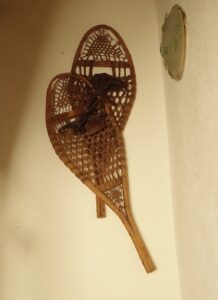 Though snowshoeing was invented in 6000BC, it was a brand new sport for me. In the old days, people made their own snowshoes - wooden-framed, rawhide-latticed wooden rackets with leather straps. I thought snowshoeing would be as simple as strapping a tennis racket to your shoe and heading out the door.
Though snowshoeing was invented in 6000BC, it was a brand new sport for me. In the old days, people made their own snowshoes - wooden-framed, rawhide-latticed wooden rackets with leather straps. I thought snowshoeing would be as simple as strapping a tennis racket to your shoe and heading out the door. Alas, the snowshoe allows only one directional forward movement. To turn right or left or at a 180 degree angle requires the dexterity of an elite gymnast.
Alas, the snowshoe allows only one directional forward movement. To turn right or left or at a 180 degree angle requires the dexterity of an elite gymnast.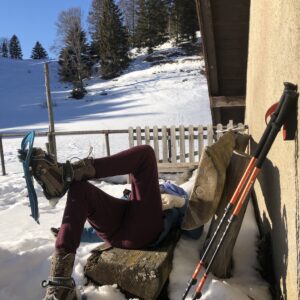 My ever patient hubby, an avid skier, encourages me to execute a "kick turn" similar to the one employed on skis.
My ever patient hubby, an avid skier, encourages me to execute a "kick turn" similar to the one employed on skis.